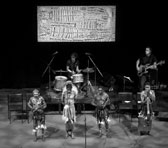25 September 2008
Very Old Meets Very New in Quest for Mutual Understanding
Crossing Roper Bar // WA // 05/09/2008
 Image: Crossing Roper Bar
Image: Crossing Roper Bar © Bohdan Warchomij
This unique and vibrant performance not only marked the conclusion of a three-week tour to regional and remote centres, but also the culmination of four years of cross-cultural collaboration. Traditional Aboriginal music was fused with contemporary jazz to a backdrop of ochre lighting, projected photographs, and a stunning, suspended Aboriginal artwork, painted by one of the performer’s grandfathers. The groundbreaking presentation of song cycles was interspersed with contemporary songs by Aboriginal singer/songwriter Ruby Hunter, whose passion, pride and sincerity were warmly appreciated by the audience.
After an official Nyoongar welcome, the stage was set for a privileged insight into the meeting of two musical cultures. Acclaimed pianist, conductor and composer Paul Grabowsky first established connections in 2004 with the Wajilak Gujarra / Nyilapidgi musicians of Ngukurr, Arnhem Land, with the aim of learning about their musical traditions, interpreting them and bringing them to the world. Fearing that the Manikay (songs) and Bunggul (dances) were at risk of disappearing altogether after decades of negative influences such as assimilation policies, Grabowsky and members of his Australian Art Orchestra (AAO) set about starting to understand and document this ancient, cultural treasure. Although by no means the first attempt by non-indigenous Australians to collaborate with traditional musicians, this project does appear to sincerely aim at an equal sharing of ideas.
Geographically, Roper Bar, near the Gulf of Carpentaria, is the point where it is possible to cross the Roper River and reach remote Ngukurr. Musically, Crossing Roper Bar symbolises the crossing between cultures, reconciliation and the bridging of gaps.
In this very ambitious musical collaboration, the audience was at first drawn in by an atmospheric soundscape created by seed pods, keyboard, flute and a gently unravelling guitar, gradually evolving into the first in a series of Wagilak song cycles. The songs were performed by traditionally dressed Ngukurr musicians, Roy Wilfred, David Wilfred, Benjamin Wilfred and Johnston Hall, who have all grown up learning the stories, dance and song from the elders and can interchange their roles of song, didjeridu, clapping sticks and dance. After several minutes of pure Wajilak music, members of the AAO began to accompany, responding to and interpreting the traditional sounds with improvised sounds of their own, on keyboard, percussion, guitar, bass guitar and saxophone. The result was a powerful and bold stridency, with each performer absorbed in the moment but still obviously strongly connected to the whole. As with the song cycles to follow, this one was concluded by unaccompanied singing by elder, Roy Wilfred.
Grabowsky then welcomed the iconic Ruby Hunter to the stage. In contrast to the traditional indigenous music, Hunter performed songs relating to her own personal experiences, backed by the AAO, in a laid-back, accessible, contemporary style. She introduced each piece by explaining the background and inspiration, and was a charismatic and engrossing speaker. Topics ranged from her journey on this current tour to the stolen generation and family, to the Australian landscape, accompanied by projected images of photographs taken on tour.
The AAO then commenced some free jazz, including wind maestro Tony Hicks taking a turn at the bass clarinet, perhaps to mirror the low range of Hunter’s voice. The Ngukurr musicians soon joined the ensemble, and the volume and the energy levels rose. After two more songs from Ruby Hunter, including the funkier Blue Sky, Cloudy Day, the AAO took centre stage and began a mellow, jazz instrumental piece entitled Hot Tin Roof. They were soon joined once again by the traditional musicians, before the rousing finale of the night, when all nine collaborative artists stood in a row and invited the audience to start clapping to the beat. The didjeridu was then played, alongside songman Roy Wilfred, and dancers, while the clapping continued, culminating in a horn-like pronouncement from the didjeridu and a resounding, high-pitched vocal call. Encores by Hunter, then the whole group, ensued, after presentations of wildflower bouquets for each musician amidst rapturous applause from the near capacity crowd.
So, how does one rate the success of such an adventurous project – in the process, the result, or both? Certainly, each musician has learnt a great deal from the others, and gaps have been bridged. Audiences from Darwin to Perth, and in many remote places in between, have been exposed not only to an interesting mix of musical styles, but have witnessed an ancient and unique musical culture. Let us hope that this is only the beginning of a focussed attempt to document, curate and preserve a style of music we can truly call Australian – music we must ensure is never lost.
Performance Details
Crossing Roper Bar
Australian Art Orchestra: Paul Grabowsky (artistic director, keyboards), Chris Bekker (bass), Tony Hicks (saxophone, flute, clarinet), Rajiv Jayaweera (drums, percussion), Stephen Magnusson (guitar)
Ngukurr Artists: Roy Wilfred, David Wilfred, Benjamin Wilfred, Johnston Hall
Ruby Hunter
Perth Concert Hall, WA
Friday 5 September
Further Links
Australian Art Orchestra (www.aao.com.au)
Tura New Music (www.tura.com.au)
Crossing Roper Bar - review in RealTime Arts (http://www.realtimearts.net/article/issue87/9154)
© Australian Music Centre (2008) — Permission must be obtained from the AMC if you wish to reproduce this article either online or in print.
Kelly Curran is currently an Honours student in the Bachelor of Music course at the Western Australian Academy of Performing Arts, majoring in composition. Several of her chamber works have been performed around Perth, and she has also composed for dance and film. She was recently nominated for a West Australian Screen Award for best score for the short film Silent Beauty. She is currently researching postmodern approaches to chamber music, and is interested in bridging the gap between popular and art music cultures.
Comments
Be the first to share add your thoughts and opinions in response to this article.
You must login to post a comment.